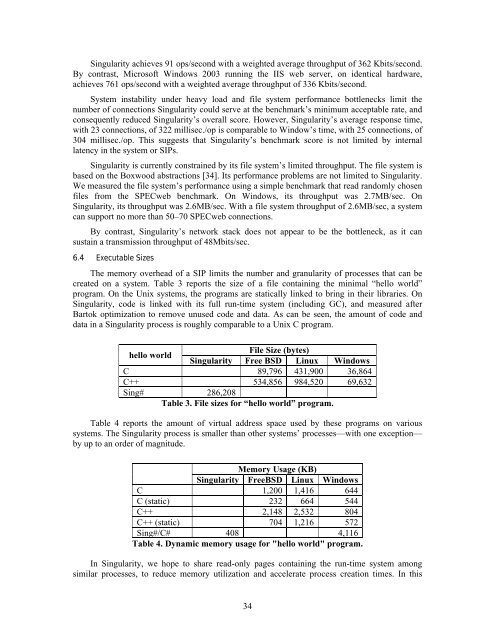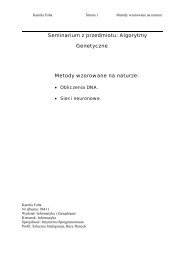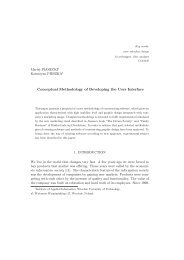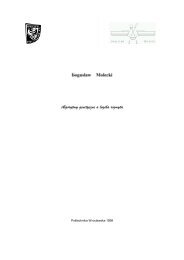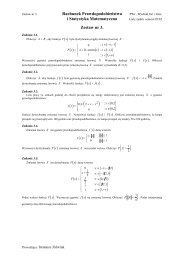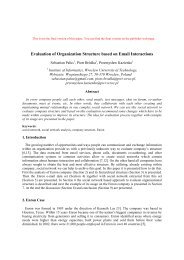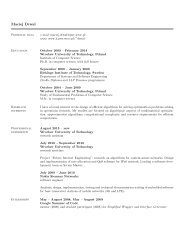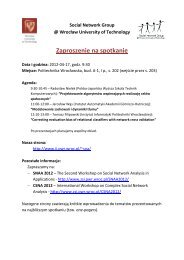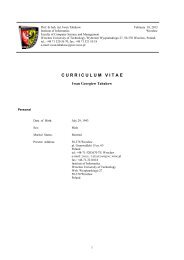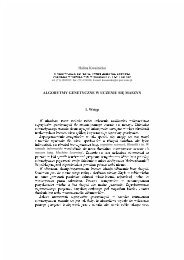Singularity achieves 91 ops/second with a weighted average throughput of 362 Kbits/second.By contrast, <strong>Microsoft</strong> Windows 2003 running the IIS web server, on identical hardware,achieves 761 ops/second with a weighted average throughput of 336 Kbits/second.System instability under heavy load and file system performance bottlenecks limit thenumber of connections Singularity could serve at the benchmark’s minimum acceptable rate, andconsequently reduced Singularity’s overall score. However, Singularity’s average response time,with 23 connections, of 322 millisec./op is comparable to Window’s time, with 25 connections, of304 millisec./op. This suggests that Singularity’s benchmark score is not limited by internallatency in the system or SIPs.Singularity is currently constrained by its file system’s limited throughput. The file system isbased on the Boxwood abstractions [34]. Its performance problems are not limited to Singularity.We measured the file system’s performance using a simple benchmark that read randomly chosenfiles from the SPECweb benchmark. On Windows, its throughput was 2.7MB/sec. OnSingularity, its throughput was 2.6MB/sec. With a file system throughput of 2.6MB/sec, a systemcan support no more than 50–70 SPECweb connections.By contrast, Singularity’s network stack does not appear to be the bottleneck, as it cansustain a transmission throughput of 48Mbits/sec.6.4 Executable SizesThe memory overhead of a SIP limits the number and granularity of processes that can becreated on a system. Table 3 reports the size of a file containing the minimal “hello world”program. On the Unix systems, the programs are statically linked to bring in their libraries. OnSingularity, code is linked with its full run-time system (including GC), and measured afterBartok optimization to remove unused code and data. As can be seen, the amount of code anddata in a Singularity process is roughly comparable to a Unix C program.hello worldFile Size (bytes)Singularity Free BSD Linux WindowsC 89,796 431,900 36,864C++ 534,856 984,520 69,632Sing# 286,208Table 3. File sizes for “hello world” program.Table 4 reports the amount of virtual address space used by these programs on varioussystems. The Singularity process is smaller than other systems’ processes—with one exception—by up to an order of magnitude.Memory Usage (KB)Singularity FreeBSD Linux WindowsC 1,200 1,416 644C (static) 232 664 544C++ 2,148 2,532 804C++ (static) 704 1,216 572Sing#/C# 408 4,116Table 4. Dynamic memory usage for "hello world" program.In Singularity, we hope to share read-only pages containing the run-time system amongsimilar processes, to reduce memory utilization and accelerate process creation times. In this34
example, approximately 280KB of the 408KB runtime originates in the executable and is notheap allocated. Of this, 137KB is code, 26KB is read-only data, and 72KB is read-write data(22KB VTables, 28KB immutable strings, and 15KB System.Type objects). With somechanges—e.g., moving locks out of immutable objects—read-write items might be shared as well.In that case, 58% of the address space would be sharable.7 Related WorkThe large amount of related work can be divided to four major areas: OS architecture,system extensibility, language safety, and defect detection.7.1 OS ArchitectureSingularity is a microkernel operating system that differs in a number of respects fromprevious microkernel systems, such as Mach, L4, SPIN, Vino, and Exokernel [2, 8, 17, 25, 46].Microkernel operating systems partition a monolithic kernel into components that run in separateprocesses. Previous systems, with exception of kernel extensions of SPIN, were written in anunsafe programming language and used processor memory management hardware and protectionrings as an isolation mechanism. Singularity uses language safety and message-passingcommunication to isolate processes and prevent access to hardware resources.Hardware-enforced processes have considerable overhead and so microkernel architecturesevolved to allow kernel extensions, while attempting to protect system integrity. SPINimplemented extensions in a safe language and using programming language features to restrictaccess to kernel interfaces [9]. Vino used sandboxing to prevent unsafe extensions from accessingkernel code and data and lightweight transactions to control resource usage [46]. Both systemsallowed extensions to directly manipulate kernel data, which left open the possibility ofcorruption through incorrect or malicious operations and inconsistent data after extension failure.Singularity’s stronger extension model prevents data sharing between a parent and an extension.Singularity also uses a single, general extension mechanism throughout the system, from devicedrivers through applications, not a specialized mechanism for a kernel. Engler’s Exokerneldefined kernel extensions for packet filtering in a domain-specific language and generated code inthe kernel for this safe, analyzable language [22]. This approach is attractive for well-defineddomains like packet filtering, but is difficult to generalize.Previous operating systems have been written in safe programming languages. Earlyexamples were “open” systems [33], that ran in a single address space and supported threads(confusingly called “processes”). They were viewed as “single user” systems, and consequentlypaid little attention to security, isolation, or fault tolerance. Smalltalk-80 and Lisp Machine Lispused dynamic typing and run-time validation to ensure language safety, but isolation depended onprogrammer discipline and could be subverted through introspective and system operations [23,54]. Pilot and Cedar/Mesa were single-user, single-address space systems implemented in Mesa,a statically typed, safe language [43, 50].Inferno is a single address space operating system that runs programs only written in a safeprogramming language (Limbo) [15]. Unlike Singularity, it supports only a single virtual machineimage, depends on dynamic code loading, and provides no memory or failure isolation.RMoX is an operating system partially written in occam [6]. Its architecture is similar toSingularity, with a system structured around message-passing between processes. However,RMoX’s uses a kernel written in C, from the OSKit, and only its device drivers and systemprocess are written in a safe language.Several operating systems have been written in Java. JavaOS is a port of the Java virtualmachine to bare hardware [44]. It replaces a host operating system with a microkernel written in35


